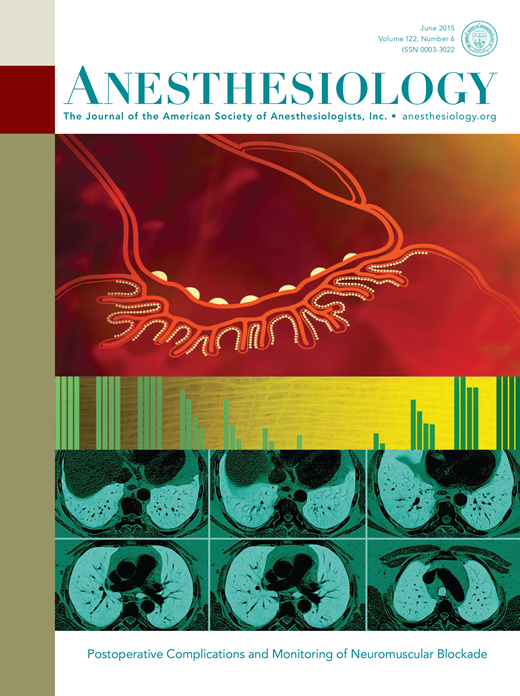Cerebral Blood Flow Under Pressure: Investigating Cerebrovascular Compliance with Phase Contrast Magnetic Resonance Imaging During Induced Hypertension.
IF 9.1
1区 医学
Q1 ANESTHESIOLOGY
引用次数: 0
Abstract
BACKGROUND Induced hypertension is used clinically to increase cerebral blood flow (CBF) in conditions such as vasospasm after subarachnoid hemorrhage. However, increased blood pressure also raises pulsatile force. Cerebrovascular compliance plays a key role in buffering flow dynamics and protecting the microcirculation, but whether it adapts to elevated pressure remains unclear. This study assessed the response of compliant cerebral arteries to induced hypertension in healthy adults using phase-contrast magnetic resonance imaging (PCMRI) and two compliance models: a two-element Windkessel (CWK) and a simplified model (CVP), representing the extremes of pulsatility transmission at the capillary level. METHODS Eighteen healthy adults (median age: 34 years; 9 females) underwent PCMRI at baseline and after increasing mean arterial pressure by 20% using norepinephrine (NE) infusion. PCMRI quantified CBF and cardiac output, while cerebrovascular resistance and systemic vascular resistance were derived. Flow waveforms were combined with blood pressure to assess CWK and CVP in CBF, ascending/descending aorta, and external carotid arteries, while corresponding regions of interest were used to calculate cross-sectional flow areas. Data are reported as median (interquartile range). RESULTS NE increased cerebrovascular compliance significantly; CWK by 110% (56% to 163%; P=0.001) and CVP by 11% (-2% to 26%; P=0.018). CWK increased in the external carotid artery by 12% (1% to 32%; P=0.037) but did not change in the ascending or descending aorta. CVP decreased in the descending aorta by 5% (-11% to 2%; P=0.028), with no changes in the ascending aorta or external carotid artery. Cross-sectional area of cerebral arteries contributing to CBF decreased by 5% (-17% to -3%; P=0.033), while the ascending and descending aorta areas increased by 7% (4% to 11%; P=0.012) and 8% (6% to 11%; P<0.001), respectively. CONCLUSION Cerebral arteries enhanced their compliance during NE-induced hypertension, unlike systemic arteries, regardless of the assumed degree of pulsatility transmission.压力下的脑血流:在诱导高血压期间用相衬磁共振成像研究脑血管顺应性。
背景:临床上,在蛛网膜下腔出血后血管痉挛等情况下,诱导高血压被用于增加脑血流量(CBF)。然而,血压升高也会增加脉搏。脑血管顺应性在缓冲血流动力学和保护微循环中起关键作用,但是否适应高压仍不清楚。本研究利用相对比磁共振成像(PCMRI)和两种顺应性模型(二元Windkessel模型(CWK)和简化模型(CVP))评估了健康成人大脑动脉对诱发高血压的反应,这两种模型代表了毛细血管水平上脉搏传递的极端情况。方法18例健康成人(中位年龄34岁;9名女性)在基线和使用去甲肾上腺素(NE)输注使平均动脉压升高20%后进行PCMRI检查。PCMRI量化CBF和心输出量,同时得出脑血管阻力和全身血管阻力。血流波形与血压结合评估CBF、升/降主动脉和颈外动脉的CWK和CVP,并使用相应的感兴趣区域计算横截面血流面积。数据以中位数(四分位数范围)报告。结果sne显著提高了脑血管顺应性;CWK增长110%(56%至163%);P=0.001)和CVP下降11%(-2%至26%;P = 0.018)。颈外动脉的CWK增加了12%(1%至32%;P=0.037),升、降主动脉无明显变化。降主动脉CVP下降5% (-11% ~ 2%;P=0.028),升主动脉和颈外动脉无变化。导致CBF的脑动脉横截面积减少了5%(-17%至-3%;P=0.033),升降主动脉面积增加7% (4% ~ 11%;P=0.012)和8%(6%至11%;分别为P < 0.001)。结论与全身动脉不同,脑动脉在ne诱导高血压期间的顺应性增强,与假定的脉搏传递程度无关。
本文章由计算机程序翻译,如有差异,请以英文原文为准。
求助全文
约1分钟内获得全文
求助全文
来源期刊

Anesthesiology
医学-麻醉学
CiteScore
10.40
自引率
5.70%
发文量
542
审稿时长
3-6 weeks
期刊介绍:
With its establishment in 1940, Anesthesiology has emerged as a prominent leader in the field of anesthesiology, encompassing perioperative, critical care, and pain medicine. As the esteemed journal of the American Society of Anesthesiologists, Anesthesiology operates independently with full editorial freedom. Its distinguished Editorial Board, comprising renowned professionals from across the globe, drives the advancement of the specialty by presenting innovative research through immediate open access to select articles and granting free access to all published articles after a six-month period. Furthermore, Anesthesiology actively promotes groundbreaking studies through an influential press release program. The journal's unwavering commitment lies in the dissemination of exemplary work that enhances clinical practice and revolutionizes the practice of medicine within our discipline.
 求助内容:
求助内容: 应助结果提醒方式:
应助结果提醒方式:


